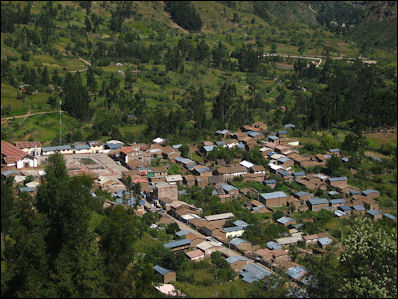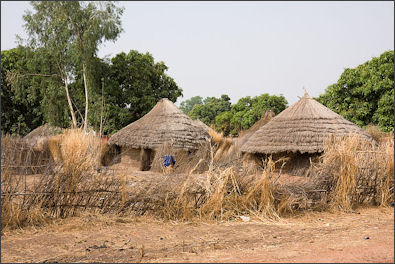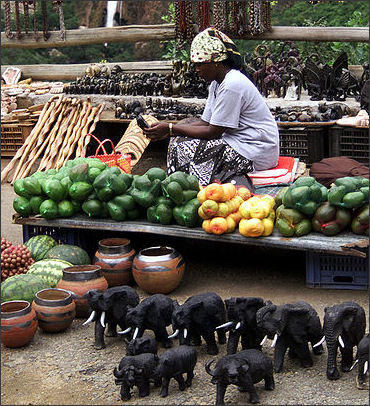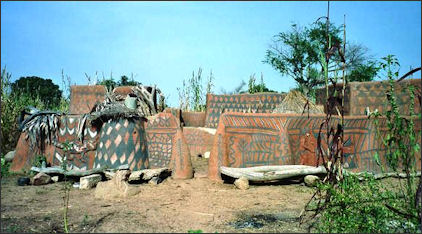TOWNS AND VILLAGES IN THE DEVELOPING WORLD

Ayacucho, Peru Most major towns and villages are located on harbors, rivers, roads or transportation hubs. Town have traditionally sprung up where different agriculture districts met and markets sprung up to allow people to trade goods. Over time the market became large enough to support a permanent population of merchants and craftsmen.
The look of small towns and villages reflects the peculiarities of the environment, building skills and technology, and available materials. Forms and shapes are determined by traditions and necessity rather than a sense of taste or aesthetics. The architect Norman F. Carver Jr. wrote: villages and towns do “not aim for an artificial impressiveness or follow an alien pattern of pretentious buildings and monumental spaces. Their impressiveness lay in the rhythmic repetition of a single house type, compact and dense, arranged to reflect the social realities of small town life."
Cities have sprung where major agricultural regions merged, often along rivers, harbors or major roads used in transportation. A typical city was established where livestock from the dry plains was traded with grain grown on irrigated plains and produce and fruit was grown in coastal areas or the mountains. As it the matured the city became surrounded by agricultural districts that produced large surpluses that could support a large population of craftsmen and merchants.
Villages
A typical village is made up of perhaps 7 to 10 clans, 50 to a 100 families and 500 or so people. Most have of individual residences and community houses such as a meeting house, religious building, men’ss house and sometimes a woman's house. Sometimes the residences are grouped together. Other times they are quite spread apart. Landowners, chiefs or traders sometimes live in a larger, nicer houses than everybody else.

Gambian villageVillages typically have a communal well, an communal area for washing clothes, and an area for threshing grain. Sewer facilities are absent. People either go in the fields or in outhouses. There are no shops, no restaurants, no bus service. These things are often a considerable distance away. If there is a road it often dead ends in the village.
Traditional villages are relatively self sufficient. Residents grow there own food. Their political and social units are the tribe and the village. Customs and traditions are passed down orally. Shaman and healers take care of health care. Someone in the village may sell things like cigarettes, soap, grain, sugar and cooking fuel out of their house.
Many people live in villages that can not even be reached by road. They can only be reached by walking paths or rutted cart tracks. These are often the poorest villages.
Loyalty to a Village
Villagers often are born, married and die in the same village. Some die without ever having ventured more than fifty miles away from their homes.
People often feel a stronger a loyalty to their village than they do towards their country or ethnic group. Even city dwellers have a strong bond to their home village even if it has been generations since their family lived there.
Almost everyone is linked in someway to a village somewhere. During holidays many city people leave the city to return to their villages. Many people like to be buried in their village along with their ancestors.
Third World Markets

African market Economic life centers around markets and market day, which is usually once or twice a week. Villagers (usually women) walk or take a bus or truck to the market town with whatever they can sell — some bananas, potatoes, beans or other crop. Items are sold or bartered.
Some markets have a pretty limited selection: potatoes, corn, cassava laid out on top of blankets on the ground. Others have a wide variety of goods and are quite lively. People dress in their best clothes and show up even if they don't want to buy or sell anything. Old friends meet and catch up on the latest gossip. Crowds of people, some with bound chickens in their hands, gather around modern-day snake oil salesmen shouting into microphones plugged into small amplifiers.
On market day the road swell with people coming and going to the market. Some women walk barefoot for several hours to get to the market, even though they have shoes because they are afraid of wearing them out and want to look good when they arrive. Many buses to markets depart at two or three in the morning so that the passengers can be at the market at the crack of dawn when most of the serious buying and selling is done. By the time late-rising tourists get to the market, most villagers have long since finished shopping and they spend the rest of the day socializing.
Choosy shoppers prefers honest, straightforward sellers. Fresh food is important and animals are bought live or freshly killed. The best selection is usually in the morning and the best prices are in the afternoon when people want to get rid of what they have. Everyone knows what a fair price is but there is usually some god natured haggling before a sale is made.
Homes in the in the Developing World
Homes generally have less space and more people than homes in the West. A typical house has two rooms for five people, compared to five rooms for two people in the United States. Two-story houses usually have a space for people on the top floor and for animals on the ground floor.
Rooms are often separated by curtains not doors or are just open. Parents and children often share the same room, and children often share the same bed. It is not unusual for three or four people to share one bed or mat. Often the parents will sleep in one area and everyone else will sleep in another area. When parents and children sleep together, parents sometimes have sex while their children are in the room.

house in Copan Honduras Houses are spaced apart to different degrees. Sometimes they are widely spaced. Sometimes they are clustered together. Often they are surrounded by vegetable gardens. Fields used grow grains and staples are further away.
Unable to get a mortgage and generally distrustful of banks anyway, many ordinary people build their homes piece by piece. A house begins with one room. New rooms or separate buildings are added when there is enough money or new family members are added.
Over the years mud-brick and thatch-roof homes have been replaced by sturdy but unsightly modern houses with corrugated metal roofs, cinder-block walls and concrete floors. The corrugated metal roofs and cinder-block walls are more durable and less likely to burn, but hotter than thatch roofs and walls.
The walls of houses built on rivers are often constructed of split and flattened palm trees and the roof is made of leaves. An oar-driven dugout canoe is the equivalent of the family car and motor-powered dugouts are the equivalent of buses. Banana trees, corn and manioc are grown in the family garden and the few chicken and pigs the family owns are allowed to run free around in the house.
Mud Houses
Wattle and daub houses are built with mud (daub) bonded with kindling-size sticks and reeds (wattle) applied to a frame made of wood or bamboo. Mud walls need several days or weeks in the sun to dry. Periodically fresh layer of mud is applied to keep the house walls from cracking.
Mud bricks are made by mixing clay, water and straw, then placing the mix into molds and then letting the bricks dry in the sun. Mud bricks are a popular building material because they are cheap and warm in the winter and cool in the summer.
Houses built of mud or mud brick and are vulnerable to heavy rains and flooding. The are dangerous in earthquake-prone areas unless they are properly reinforced. Unlike houses made of concrete and wood that collapse in jumbles and leave gaps for survivors, mud brick homes tend to crumble in piles. Many people die from being crushed; other suffocate from the weight of the brick on top of them, lack of air and breathing in dust.
Thatch Roof Houses

Nuba villageA traditional thatch roof hut has a thatch roof, dirt floor and no windows. The walls of the hut are constructed with sticks or bamboo lashed loosely together to allow air to circulate. Many are built with stilts, which prevent the house from being flooded during the wet season and protect people from animals and crawling insects.
Thatched roofs adequately repel rain and are cool in hot weather and warm in cool weather. Tin roofs are very noisy when it rains. Thatch and grass roofs are sometimes so quiet you have to look outside to make sure it is raining. On the downside, thatched roofs easily catch fire and spread the fire to other thatched roofs.
The frame is ideally made of a hard wood that has been stripped and dried and in some cases treated with salt water as protection from termites. The thatch is made of leaves, grass of palm leaves and has to be around 25 to 30 centimeters thick to provide enough protection for the rain. In many cases no screws or nails are used. Instead the frames is bound tegether and the thatch is tied to the frame by hand with lashings made of a strong material such as hemp fibers or braided coconut husks.
The cost of building such a house is often less than $300. This price includes timber for stilts and beams, split bamboo for the walls, bamboo mats for floors, labor, and animals for a sacrifice. Gathering the materials from the forest and preparing them takes about three days; building the house takes only a day. The hardest task is setting the timber stilts and building the frame. The construction of the fireplace — a wooden frame filled with sand — is "entrusted only to older men." There is often some sort of ritual involved in choosing a site and orienting for a house and make it safe from evil spirits once it is built.
Desert Homes
Many villagers in dry areas live in one or two story, flat-roof, mud-brick houses that are the same color as the land around them because they are made of the same material. The bricks are made from mud mixed with wheat straw and shaped in wooden boxes or molds. The bricks are bonded together with more mud and straw to make walls. The roof is made of split palm trunks covered by palm fronds or corn stalks and mud. The roofs are flat because they do not need to shed rain. Thick walls keep the inside cool in summer and warm in the winter.

Bolgatanga painted village The homes of landowners are often two or three stories. Those belonging to the poor often only have two rooms: one for the family and one for the animals. There is usually one entrance used by both animals and people, windows with wooden shudders and no glass, and a packed earth floor.
Concrete homes that have replaced traditional mud-brick homes are not as cool as the traditional mud brick homes. When asked if the mud houses were hot inside, one man told National Geographic, "Never! These old mud-brick houses were the coolest houses you can imagine. Not like the concrete ovens they build now.”
House are often kept cool with various devices such as high windows and vents that catch wind and dry desert air and send it through the house.
Courtyard Homes
Many homes consist of different buildings or one angled structure built around a courtyard. The openings of the buildings faced inward towards the courtyard rather than outward towards the street and other buildings. The walls are made of sun dried bricks placed on a stone foundation. The walls and roofs are supported and reinforced by timbers and beams.
In front of the courtyard is a large, living room with family treasures such as an altar with religious objects and pictures of living and deceased relatives. Guests are entertained here; friends and family gather here to socialize and relax.
In small buildings placed around the living room are bedrooms, a kitchen and dining room and other rooms. In larger houses and villas the bedrooms, recreation rooms, libraries, guest rooms, baths, eating chambers and other facilities are often in separate wings.
The roof of the house is covered by ceramic tiles and designed so it directs waters into a storage basin. Rural houses are surrounded by animals pens, orchards and gardens that vary in size depending on how rich the owner is. Often times there are animals pens, fruit trees and gardens in the courtyard.
Concrete Tents

mountain home in Turkey Many refugees and internally displaced people live in soft-skinned fabric tents, which can be very cold in winter, are vulnerable to high winds and can be made unusable in as little as three weeks. More permanent shelters are hard to transport and take time to build.
Peter Breweun and William Crawford developed a new super strong material — called concrete canvas — for a design competition at their school, the London’s Royal College of Art. After a trip to Uganda, where they saw flimsily huts easily set on fire by rebels, refugee camp tents swamped by strong rains and supply tents easily broken into and their contents stolen, they decided to put their invention to use for humanitarian uses. The result: igloo-like tents that are as strong as houses.
Concrete canvas is made of cement-impregnated fabric folded into a plastic sack. After the fabric is saturated with water, the structure is inflated , and dries to form a an impermeable shell. The shelters can be sterilized and made into field hospitals where operations can be performed. They can be secured with a locking door, sealed with earth or sandbags and ventilated with windows cut out of the skin, They come in three sizes: ranging from 52 to 177 square feet of floor space and can be joined together to make larger structures. The largest models, which can accommodate 15 people, weigh between 200 and 400 kilograms. They can be delivered by truck or light aircraft. Smaller versions can be erected by two people in an hour. An additional 12 hours is needed for it to dry. NGOs, the military and individuals have all shown interest in the technology.
Image Sources: Wikimedia Commons
Text Sources: New York Times, Washington Post, Los Angeles Times, Times of London, Yomiuri Shimbun, The Guardian, National Geographic, The New Yorker, Time, Newsweek, Reuters, AP, Lonely Planet Guides, Compton’s Encyclopedia and various books and other publications.
Last updated January 2012
